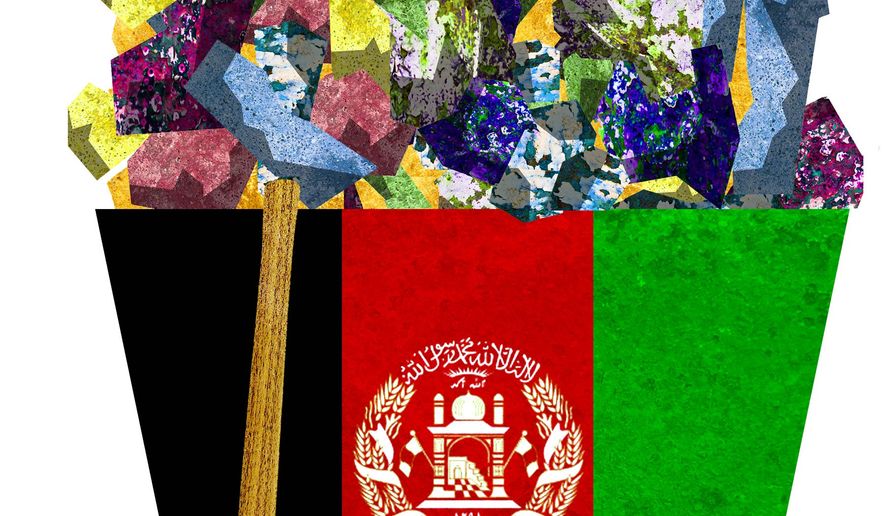OPINION:
Last August, the Trump administration authorized a military escalation in Afghanistan in the hopes of bringing the Muslim Taliban insurgency to its knees. No one actually believes that the insurgency, which still controls 40 percent of the national territory, can be defeated outright. But the idea is to convince the Taliban to stop fighting, agree to a transitional coalition government and participate in national elections.
It hasn’t worked elsewhere, and it’s hard to imagine reconciling the claims of “modern” secular government with those of extreme Muslim fundamentalists, who once ruled Afghanistan outright (1996-2001).
Moreover, Afghanistan is an impoverished country with a highly under-performing agriculture-based economy. Farmers produce wheat and grapes among other traditional cash crops. But most of the country’s annual revenues — and nearly half of its GDP — derive from the cultivation of poppies that are transported illegally into Pakistan and Iran to fuel the global heroin trade.
Heroin has corrupted Afghan society from top to bottom, and it’s fueling the current war. About 40 percent of the Taliban’s Treasury is dependent on heroin sales. And the Afghan government, especially in local areas, has been quietly exploiting the poppy trade, too. The United States has spent a whopping $8.5 billion on poppy “eradication” campaigns that have gone nowhere. Not surprisingly, in a country this poor and administratively weak, a good portion of the money seems to have ended up in the pockets of officialdom.
In Kabul, the nation’s capital, one-sixth or the adult population is comprised of heroin addicts. You can see them shooting up in broad daylight under bridges and along roadsides. Figuratively, if not literally, Afghanistan might one day “overdose,” unless a solution is found.
In fact, an alternate future for the country may well be possible, some global policy specialists say. It is based on exploiting Afghanistan’s vast untapped mineral resources, a monumental challenge that would require not only peace and national unity but the creation of a new regulatory regime and an infusion of outside investment to create the rudiments of a modern extractive industry.
The mineral wealth is certainly there. A little-noticed geological survey conducted by the Pentagon in 2010 found that Afghanistan is rich in precious gems, especially emeralds and rubies, as well as gold and cobalt and rare earth metals needed to produce “smart” phones and battery-grade lithium deposits previously thought to exist on this scale only in China, Bolivia and Chile. These impressive discoveries might one day finance real development, economists and mining experts say.
But right now, Afghanistan’s mineral trade, like its opium trade, is still rife with corruption, and inextricably bound up with the ongoing war. In fact, in northern provinces, Taliban rebels rely on the sale of rubies, emeralds and lapis luzuli to finance their purchase of weapons and ammunition.
And even in semi-autonomous areas like the Panjshir Valley, which has resisted Taliban encroachments, 80 percent of the emerald trade is still off the books. The central government has tried to tax the emerald trade, but it lacks the administrative authority and know-how.
And the mines themselves are still largely inaccessible — perched inside mountain ridges accessible by mule — and primitive in construction, often lacking support structures to prevent collapse. Even worse, local miners still use gunpowder to search for new deposits and some of the best gems are destroyed or damaged in the process.
But there is a ray of hope — however slender. In recent years, a number of private firms like Aria Gems that work closely with the tribes and elders of the Panjshir are being contracted by the U.S. State Department to upgrade mining methods, and the firm is eagerly promoting the region’s emeralds — considered to be the most beautiful in the world — abroad. The firm cuts and polishes its gems in Fargo, N.D., then distributes them to wholesalers in Shanghai and Dubai as well as New York and Los Angeles.
Securing buyers has turned out to be a bigger challenge than getting the emeralds out of the ground. In fact, there’s already a glut of emeralds available on the world market. “We have millions of karats of emeralds sitting in Dubai in warehouses, waiting for wholesale buyers. The challenge is to turn those cut gemstones into retail jewelry,” says one Aria Gems executive, who prefers not to be identified because of security concerns.
The firm contracts about two dozen miners and manages the largest and most lucrative legal mines in the Panjshir. It also sponsors health and infrastructure building projects to set an example of how emerald sales might contribute to peace and development.
Still, it could take a generation to build up the mining infrastructure and to attract the foreign investment needed to construct a world-class extractive industry.
The Aria Gems executive says an important next step would be to train miners to cut and polish their own gemstones prior to export. That would allow more of Afghanistan’s prospective mineral revenues — estimated at $1 trillion, but now just a fraction of that amount — to stay inside the country, rather than be siphoned off by foreign entities.
“Afghanis have suffered under years of foreign occupation and war. It’s going to take time. But I’m convinced that emeralds can show the way,” he says.
The White House could strengthen the pioneering efforts of groups like Aria Gems if it invoked Section 1502 of the Dodd-Frank Act. The bill’s little known “conflict minerals” provision stigmatizes the sale of gems mined by military forces hostile to democracy; in theory, it might make it harder for the Taliban to purchase arms. But like any sanctions measure, the danger is that the livelihoods of Afghan farmers innocently sucked into the war could well suffer, too.
Still, with Afghanis and Americans still bleeding, even this small step toward peace might help.
• Stewart Lawrence is a Washington writer.




Please read our comment policy before commenting.